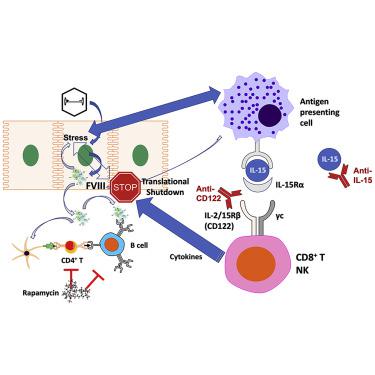Molecular Therapy ( IF 12.1 ) Pub Date : 2022-07-12 , DOI: 10.1016/j.ymthe.2022.07.005 John S S Butterfield 1 , Kentaro Yamada 2 , Thais B Bertolini 2 , Farooq Syed 2 , Sandeep R P Kumar 2 , Xin Li 2 , Sreevani Arisa 2 , Annie R Piñeros 2 , Alejandro Tapia 2 , Christopher A Rogers 2 , Ning Li 2 , Jyoti Rana 2 , Moanaro Biswas 2 , Cox Terhorst 3 , Randal J Kaufman 4 , Ype P de Jong 5 , Roland W Herzog 2

|
Hepatic adeno-associated viral (AAV) gene transfer has the potential to cure the X-linked bleeding disorder hemophilia A. However, declining therapeutic coagulation factor VIII (FVIII) expression has plagued clinical trials. To assess the mechanistic underpinnings of this loss of FVIII expression, we developed a hemophilia A mouse model that shares key features observed in clinical trials. Following liver-directed AAV8 gene transfer in the presence of rapamycin, initial FVIII protein expression declines over time in the absence of antibody formation. Surprisingly, loss of FVIII protein production occurs despite persistence of transgene and mRNA, suggesting a translational shutdown rather than a loss of transduced hepatocytes. Some of the animals develop ER stress, which may be linked to hepatic inflammatory cytokine expression. FVIII protein expression is preserved by interleukin-15/interleukin-15 receptor blockade, which suppresses CD8+ T and natural killer cell responses. Interestingly, mice with initial FVIII levels >100% of normal had diminishing expression while still under immune suppression. Taken together, our findings of interanimal variability of the response, and the ability of the immune system to shut down transgene expression without utilizing cytolytic or antibody-mediated mechanisms, illustrate the challenges associated with FVIII gene transfer. Our protocols based upon cytokine blockade should help to maintain efficient FVIII expression.
中文翻译:

IL-15 阻断和雷帕霉素可挽救 AAV 小鼠 AAV 转导肝细胞中因子 VIII 的多因素丢失
肝腺相关病毒 (AAV) 基因转移有可能治愈 X 连锁出血性疾病 A 型血友病。然而,治疗性凝血因子 VIII (FVIII) 表达的下降一直困扰着临床试验。为了评估 FVIII 表达缺失的机制基础,我们开发了 A 型血友病小鼠模型,该模型具有临床试验中观察到的关键特征。在存在雷帕霉素的情况下进行肝脏定向 AAV8 基因转移后,在没有抗体形成的情况下,初始 FVIII 蛋白表达随着时间的推移而下降。令人惊讶的是,尽管转基因和 mRNA 持续存在,但 FVIII 蛋白产生的损失还是发生,这表明翻译关闭而不是转导肝细胞的损失。一些动物会出现内质网应激,这可能与肝脏炎症细胞因子的表达有关。 IL-15/IL-15 受体阻断可保留 FVIII 蛋白表达,从而抑制 CD8 + T 和自然杀伤细胞反应。有趣的是,初始 FVIII 水平>正常值 100% 的小鼠在仍处于免疫抑制的情况下表达逐渐减少。总而言之,我们对动物间反应差异的发现,以及免疫系统在不利用细胞溶解或抗体介导机制的情况下关闭转基因表达的能力,说明了与 FVIII 基因转移相关的挑战。我们基于细胞因子阻断的方案应有助于维持有效的 FVIII 表达。









































 京公网安备 11010802027423号
京公网安备 11010802027423号